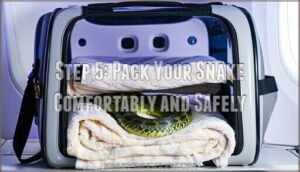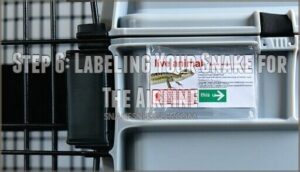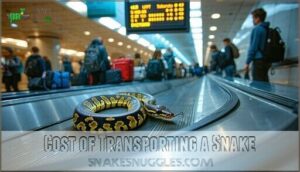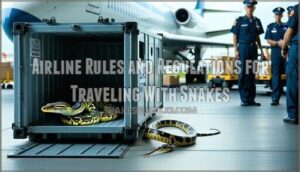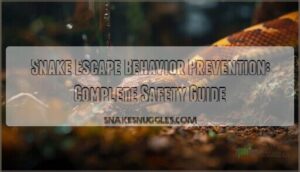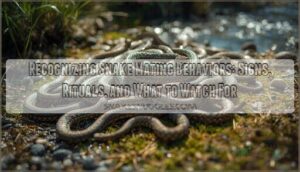This site is supported by our readers. We may earn a commission, at no cost to you, if you purchase through links.

Most airlines won’t let snakes slither into the cabin or checked luggage, so you’ll need to ship yours as air cargo.
You’ll have to get an IATA-approved container, follow strict temperature guidelines, and expect paperwork that could rival a small novel.
Costs can climb fast, especially for longer trips or larger snakes.
Always check with your airline, as each one has its own maze of rules.
It’s not a walk in the park, but with the right prep, your snake can travel safely.
Ready for expert tips on making your journey smoother?
Table Of Contents
- Key Takeaways
- Can You Fly With a Snake?
- Airline Rules for Traveling With a Pet Snake
- Step 1: Find Your Snake a Suitable Travel Bag
- Step 2: Ensure Proper Temperature Conditions
- Step 3: Protect Your Snake During The Flight
- Step 4: Don’t Forget to Bring a Thermometer
- Step 5: Pack Your Snake Comfortably and Safely
- Step 6: Labeling Your Snake for The Airline
- Cost of Transporting a Snake
- Airline Rules and Regulations for Traveling With Snakes
- Frequently Asked Questions (FAQs)
- How to travel with a pet snake?
- Can you bring reptiles through TSA?
- What are the rules for flying with animals?
- Can snakes be shipped internationally by mail?
- Are there any additional restrictions or quarantine requirements for traveling with a snake?
- Is it necessary to label the snake’s travel carrier for the airline?
- What documents are required for international snake transport?
- How long before departure should I book?
- Can venomous snakes be transported on airlines?
- What happens if my snake escapes during transit?
- Conclusion
Key Takeaways
- You can’t bring snakes in the cabin or as checked baggage – they must travel as air cargo with specialized shipping services, costing $200-$4,000 depending on your route and carrier.
- You’ll need an IATA-approved hard-sided container with proper ventilation, secure locks, and temperature control systems to keep your snake safe during transport.
- Advance planning is crucial – book at least 14 days ahead and gather required documentation including health certificates, travel permits, and species-specific paperwork that varies by destination.
- Most major airlines ban snakes entirely, but a few like American Airlines, Lufthansa, and Air France accept them through cargo services with strict safety protocols and temperature monitoring.
Can You Fly With a Snake?
You can fly with a snake, but only as checked baggage or cargo since airlines don’t allow snakes in the cabin.
Most major airlines have strict policies against snakes due to safety concerns, though a few like American Airlines and Aegean Air permit them in cargo holds with proper enclosures and advance booking.
Airlines That Allow Snakes
Regarding flying with snakes, you’re looking at limited options since most major airlines don’t allow these slithery companions.
However, a handful of international carriers like Lufthansa and Air France do accept snake cargo through specialized pet shipping services.
American Airlines permits snakes as checked baggage with strict airline pet policies, while Delta only handles them as cargo with advance booking.
These airline snake restrictions mean you’ll need travel permits, proper documentation, and expect significant airline fees.
Flying with snakes requires traversing complex snake travel regulations that vary by carrier and destination.
Further Restrictions on Flying With a Snake
Beyond airline pet policies, you’ll face a maze of additional hurdles when flying with your snake.
Flying with your snake means navigating a complex web of airline restrictions, documentation requirements, and safety protocols that can turn your travel plans upside down.
Import laws and export fees vary dramatically between countries, often requiring snake permits and extensive travel documents months in advance. Border controls scrutinize reptile shipments heavily, and many destinations ban specific species outright.
Consider these critical restrictions:
- CITES documentation – Endangered species need verified captive-bred certificates and international permits
- Quarantine requirements – Some countries mandate weeks-long isolation periods upon arrival
- Seasonal embargoes – Airlines halt reptile transport during extreme weather conditions
International snake travel demands thorough research of destination laws. Snake travel regulations change frequently, and airline snake restrictions often exceed federal requirements.
Non-compliance can result in hefty fines or confiscation of your pet.
How to Transport a Snake Long Distance
Long-distance snake transportation requires careful planning and proper equipment.
You’ll need an approved snake travel carrier that meets airline pet rules and specific snake enclosures requirements.
Research travel permits for your destination, as international snake travel often involves additional documentation.
Factor in airline fees, which can range from $200-4000 depending on the carrier.
Follow your reptile travel checklist closely – proper ventilation, secure latching, and temperature control are non-negotiable for snake safety in the cargo hold.
Always review current snake transportation guidelines before booking your flight.
Airline Rules for Traveling With a Pet Snake
You’ve established that flying with snakes is possible, but managing airline pet policies requires careful planning. Most major carriers have strict airline rules and regulations for snakes that you can’t ignore.
**Snakes can’t be carried on as carry-on luggage.
**Instead, they must travel as checked baggage or in the cargo hold.
** Snake enclosures must meet specific airline standards – hard-sided containers with proper ventilation and secure locks.
Each airline has different snake policies, so you’ll need to contact them directly before booking.
Key requirements include:
- Health certificates from a licensed veterinarian (usually within 10 days of travel)
- Travel permits for certain species or destinations
- Advance booking confirmation (typically 14+ days ahead)
Pet fees for snake transport range from $200-$800 per container, depending on your route and carrier. Airport security will inspect your documentation, so keep all paperwork accessible.
Temperature control becomes your biggest challenge since cargo holds can get dangerously cold. Some airlines require additional insulation or heating elements to maintain proper conditions for your reptile throughout the journey.
Step 1: Find Your Snake a Suitable Travel Bag
Your snake needs a proper travel container that prioritizes safety and comfort. Choose a pet carrier made from durable materials like hard plastic or reinforced fabric that can withstand airline handling.
Size matters – your snake should fit comfortably without excessive room to slide around during turbulence. Ventilation needs are critical, so select carriers with mesh panels or air holes for proper airflow.
Security features like secure latches prevent escapes. Different carrier types include soft-sided bags for smaller snakes and rigid containers for larger species, but all must meet snake travel carrier requirements.
When selecting a carrier, consider the specific travel carrier options available for your snake’s needs, ensuring the carrier provides the necessary protection and meets the required standards for a safe and comfortable journey.
Step 2: Ensure Proper Temperature Conditions
Once you’ve chosen the right travel bag, temperature control becomes your next priority. Snakes can’t regulate their own body heat, making proper thermal regulation critical for their safety during air travel.
Maintain temperatures between 45°F and 85°F inside your snake’s travel enclosures. Use heat packs designed specifically for snake travel, positioning them outside the container to prevent direct contact. Hand warmers or microwaveable heat pads work well for climate management, but always test temperatures before placing your snake inside.
Add thick bedding material for insulation and comfort. This creates a buffer zone that helps maintain consistent temperature conditions for snakes throughout the journey.
Essential temperature control considerations:
- Monitor ambient cargo hold temperatures, which can drop substantially during flight
- Use multiple heat sources for redundancy in case one fails
- Test all heating devices before travel day
- Pack extra heat packs for unexpected delays
- Consider your snake’s species-specific temperature requirements
Proper snake temperature control isn’t just comfort—it’s survival during air transport.
Step 3: Protect Your Snake During The Flight
After securing proper temperature conditions, you’ll need to safeguard your snake against flight risks that could compromise their well-being. Cargo holds expose snakes to noise, vibrations, and rough handling that can cause significant stress.
Cargo holds turn flights into stress-filled ordeals for snakes through noise, vibrations, and rough handling.
Temperature control becomes your primary concern since cargo areas experience dramatic temperature swings during loading and at altitude. Pack extra insulation around your snake’s carrier to buffer against temperature fluctuations.
Include heat packs designed for reptile transport, following airline regulations for snakes regarding chemical heating elements. Position these safely outside the travel container to prevent direct contact.
Snake comfort during travel depends on minimizing movement within the carrier. Use appropriate bedding to prevent sliding while allowing natural positioning. Make certain snake travel safety by double-checking all latches and ventilation holes before departure.
When choosing a carrier, consider investing in high-quality reptile travel bags to provide the best protection for your snake. Travel precautions include preparing for delays. Pack backup heating solutions and inform airline staff about your live cargo.
Snake safety requires constant vigilance – one oversight can turn your journey into a nightmare for your reptilian companion.
Step 4: Don’t Forget to Bring a Thermometer
Beyond the travel carrier itself, temperature control stands as your snake’s lifeline during air travel. Cargo holds can fluctuate dramatically, making thermometer usage essential for snake safety.
Critical temperature monitoring steps:
- Check species-specific temperature requirements – Most snakes need 70-85°F, but verify your pet’s exact needs
- Pack backup heat packs – Airline cargo holds often drop below safe temperatures during flight
- Use digital thermometers – They’re more accurate than analog versions for precise climate monitoring
- Monitor both ambient and surface temps – Place one thermometer inside the carrier, another on the outside
- Prepare cooling options too – Ice packs wrapped in towels prevent overheating during ground delays
Travel precautions include testing your thermometer beforehand and keeping spare batteries handy. Temperature conditions can shift quickly during layovers, so consistent monitoring protects your snake from dangerous temperature swings that could prove fatal.
Step 5: Pack Your Snake Comfortably and Safely
Proper packing transforms a stressful journey into a smooth experience for your scaly companion. Your snake’s comfort depends on selecting the right travel carriers and implementing smart packing tips that prioritize both safety and well-being.
Snake enclosures for travel should provide adequate ventilation systems while maintaining security. Place your snake in a breathable cloth bag or pillowcase first, then position this inside the main snake travel container. This double-layer approach prevents direct contact with hard surfaces while allowing natural movement.
| Packing Element | Purpose | Best Practice |
|---|---|---|
| Container Size | Prevents sliding | Choose snug-fitting carrier |
| Bedding Material | Comfort & absorption | Use paper towels or fleece |
| Ventilation | Air circulation | Make certain multiple air holes |
| Insulation | Temperature stability | Add towels around container |
| Securing Method | Prevent escapes | Double-check all latches |
Safety measures include securing the lid with airline-approved locks and padding the container’s exterior. Temperature control for snakes remains critical—avoid placing heat sources directly inside the enclosure. Instead, wrap the entire container in insulating materials to maintain stable conditions throughout snake comfort during airline travel. This ensures a safe and comfortable journey for your scaly companion with proper temperature stability.
Step 6: Labeling Your Snake for The Airline
Once your snake is packed safely, you’ll need proper labeling to meet airline pet regulations. Airlines require specific snake identification on all containers traveling in cargo.
Your shipping documents must include the snake’s species, your contact information, and "Live Animal" markings in bold letters. Most carriers demand standardized cargo tags that follow live animal labeling protocols.
These airline forms typically require the snake’s scientific name, not just common names. Include arrows showing the container’s upright position and "This Side Up" labels. Your travel documentation should list any special handling instructions, like temperature requirements or feeding schedules.
Some airlines provide their own label requirements, so check with your carrier beforehand. Proper labeling prevents delays and guarantees your snake receives appropriate care during transport. Clear, accurate labels help cargo handlers identify your pet quickly and handle the container according to airline rules for live animals.
Using correct live animal labels is vital for guaranteeing the safe transport of your snake.
Cost of Transporting a Snake
Flying with your snake involves several expense categories you’ll need to budget for carefully. Major airlines charge $150-$375 for reptile cargo transport, with international flights often exceeding $500.
You’ll also face documentation costs like health certificates ($75-$200) and import permits (up to $100).
- Air freight costs vary by carrier and distance – domestic flights typically cost less than international routes, but expect additional handling fees of $60-$120 per booking.
Transport costs include airline-approved containers ($40-$150), heat packs for temperature control ($5-$15), and travel insurance ($20-$65).
Specialized reptile shipping services offer door-to-door transport for $200-$750, while premium white-glove service starts at $500. Don’t forget seasonal surcharges can increase cargo prices by 20% during peak travel times.
Understanding the total snake ownership costs is essential for planning a stress-free and budget-friendly trip with your pet snake.
Airline Rules and Regulations for Traveling With Snakes
Understanding airline rules and regulations for traveling with snakes isn’t rocket science, but it does require careful planning and attention to detail.
Each airline maintains distinct airline pet policies 2023 that dictate how you can transport your serpentine companion. Most major carriers follow IATA Live Animal Regulations, but their specific airline policies on snakes vary substantially.
You’ll need to contact your airline directly to understand their snake travel regulations and any species restrictions they enforce.
Key requirements you’ll encounter include:
- Travel Permits – Health certificates and CITES documentation for protected species
- Snake Enclosures – IATA-compliant containers with proper ventilation and escape-proof design
- Cargo Fees – Typically $200-$4,000 depending on destination and specialized transport needs
Airport security will inspect your documentation and container before departure.
Remember, airline restrictions on snakes often prohibit venomous species entirely, while non-venomous snakes must travel as cargo only—never in the cabin.
Frequently Asked Questions (FAQs)
How to travel with a pet snake?
Here’s a heart-stopping reality: you’ll need cargo hold transport, proper enclosures, health certificates, and advance booking.
Most airlines restrict snakes due to temperature risks and safety concerns, making careful planning absolutely essential.
Can you bring reptiles through TSA?
You can’t bring reptiles through TSA as carry-on items. They must travel as checked cargo with approved airlines like American Airlines or Delta, requiring special containers and advance booking.
What are the rules for flying with animals?
Airlines have specific rules for animal transport.
Most pets travel in cabin or cargo, depending on size.
You’ll need health certificates, proper carriers, and advance booking.
Fees typically range from $100-500 per animal.
Can snakes be shipped internationally by mail?
Some mail carriers halt shipments due to customs changes.
USPS bans shipping snakes and most other reptiles altogether, requiring specialty shippers for international transport.
You’ll need private courier services, not regular postal mail, for international transport.
Are there any additional restrictions or quarantine requirements for traveling with a snake?
Yes, you’ll face destination-specific restrictions and quarantine requirements when traveling with snakes. Research your destination’s wildlife import laws, obtain necessary permits, and contact local agriculture offices for current regulations.
Is it necessary to label the snake’s travel carrier for the airline?
Surprisingly, proper labeling isn’t just recommended—it’s essential for your snake’s safe passage.
You’ll need clear labels indicating "Live Animal," species information, handling instructions, and your contact details to guarantee proper cargo handling.
What documents are required for international snake transport?
You’ll need import/export permits, health certificates, veterinary inspection forms, and airline-approved documentation. Each country has specific requirements, so contact your destination’s agriculture office beforehand to avoid complications.
How long before departure should I book?
Like traversing uncharted waters, booking your snake’s flight requires planning ahead.
You should book at least 14 days before departure, as Delta requires this timeframe and other airlines have similar advance booking requirements.
Can venomous snakes be transported on airlines?
Venomous snakes are universally banned on all commercial flights.
Only non-venomous snakes can travel by air. Airlines won’t budge on this safety rule, protecting passengers and crew from potentially deadly encounters.
Airline policies often cite snake transport rules as a key factor in their decision-making process, emphasizing the importance of adhering to strict guidelines for snake transport.
What happens if my snake escapes during transit?
If your snake escapes during transit, it triggers emergency protocols.
Airlines will ground the aircraft, conduct searches, and potentially divert flights.
You’ll face liability for damages, delays, and safety responses—making secure, escape-proof containers absolutely critical.
Conclusion
Ironically, learning how to fly with a snake including airline rules reveals that your slithery companion can’t actually fly alongside you.
Most airlines ban snakes from cabins and checked baggage entirely. You’ll need specialized air cargo services with IATA-approved containers, temperature controls, and extensive documentation.
While complex and costly, proper preparation guarantees your snake’s safe transport. Research airline policies early, invest in quality equipment, and budget for professional shipping services to navigate this challenging process successfully.




